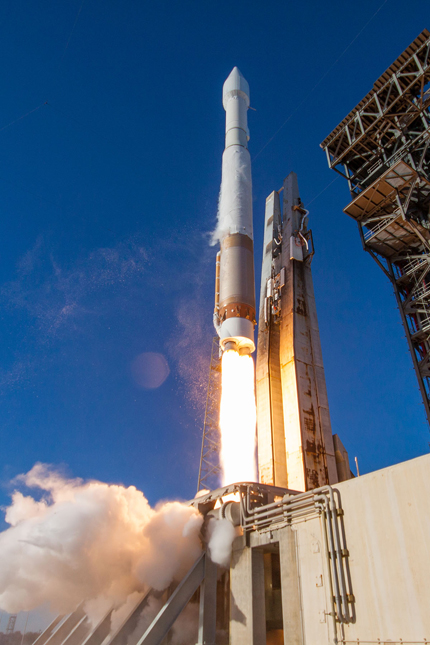Atlas 5 rocket boosts GPS satellite into space
A United Launch Alliance Atlas 5 rocket thundered into space Friday, boosting the 12th and final member in a series of upgraded Global Positioning System satellites into space, the eighth navigation beacon launched in less than two years.
After overnight concerns about high winds, the Atlas 5, making the first of up to 15 flights planned by ULA in 2016, thundered to life at 8:38 a.m. EST (GMT-5) and majestically climbed away from pad 41 at the Cape Canaveral Air Force Station.
With its Russian-built RD-180 first-stage engine generating more than 860,000 pounds of thrust, the 700,000-pound rocket quickly accelerated as it consumed its kerosene and liquid oxygen propellants, breaking through the sound barrier just 78 seconds after liftoff and arcing away to the east.
The RD-180, making its 67th flight, chalked up another apparently flawless performance, shutting down as planned four minutes after ignition. The first stage then fell away and the single Aerojet Rocketdyne RL10C engine powering the Centaur second stage ignited to continue the climb to space.
The hydrogen-fueled Centaur engine fired for just under 13 minutes, boosting the GPS 2F-12 satellite into an initial near circular orbit with an average altitude of 12,700 miles. A second one-minute 27-second firing was carried out three hours later to complete the launch phase of the mission and the spacecraft was released from the Centaur stage just after noon.
The GPS 2F-12 satellite is the 12th and final spacecraft in a series of Boeing-built navigation satellites, joining an active constellation of 30 operational spacecraft and several on-orbit spares and retired spacecraft.
The Air Force "is currently engaged in a very aggressive campaign to modernize the GPS system across all three segments -- space, ground and user equipment," said Col. Steve Whitney, director of the Global Positioning Systems Directorate at the Air Force Space and Missile Systems Center.
"The result of this campaign will provide stronger signals, additional civil signals and improve the robustness of the overall system architecture."
GPS satellites operate in six orbital planes at an altitude around 12,500 miles, each one transmitting ultra-precise time signals from on-board atomic clocks along with extremely accurate position information.
With a constellation of at least two dozen satellites, at least four spacecraft are above a user's horizon as viewed from anywhere on or above Earth. Compact receivers can then combine the signals from visible GPS satellites to calculate the user's location, velocity and altitude to within a few feet.
"The GPS 2F satellites bring improved accuracy through better clocks, longer design life, a third civil signal for aviation and safety-of-life applications (and) they also include a more robust military signal," Whitney said.
Just how accurate are the GPS 2F satellites for military users?
"The metric we use there is called 'user range error,' that's how far the user thinks he's off from where he (actually) is," Whitney said. "Prior to the 2F satellites being placed on orbit, that metric was somewhere in the neighborhood of a meter to 90 centimeters on any given day. As we've brought the 2Fs on orbit, we've seen that drop down."
Last week, he said, the average daily range error was around 42 centimeters, or about 16 inches, which he said could mean the difference between a GPS-guided bomb flying into a window or missing its target.
"Fifty centimeters can be the difference of a soldier, sailor, airman, marine being in the right spot behind protection as he's taking fire or the right spot to deliver fire," Whitney said. "Centimeters is a lot."
With launch of the final GPS 2F-series satellite, the Air Force will focus on completing tests and checkout of the next generation GPS-3 navsats. The first GPS-3 satellite is expected to fly in mid 2017.


